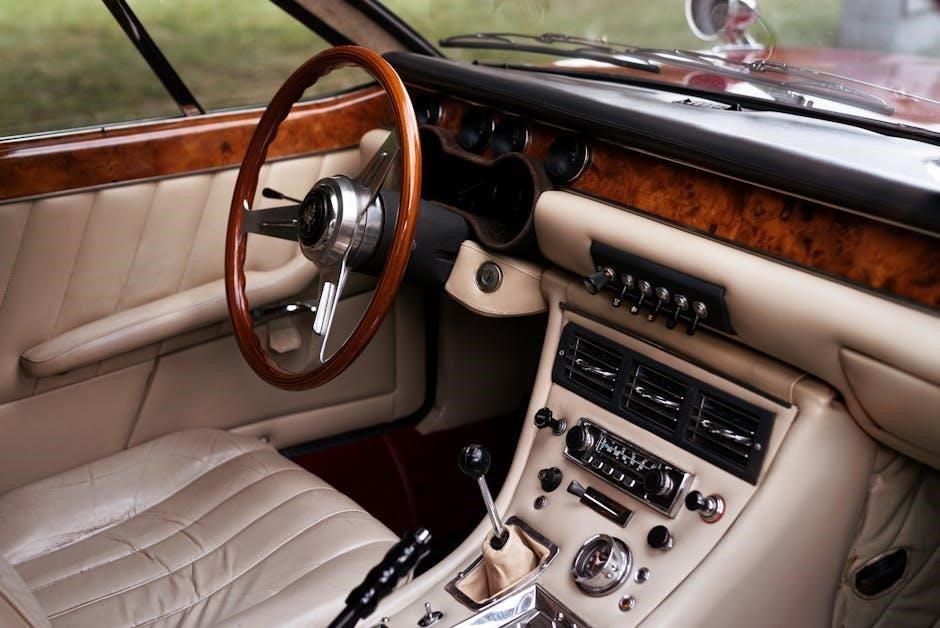Manual shifting the 4L60E offers enhanced control and performance. By engaging gears directly, drivers optimize acceleration and responsiveness, especially in high-performance scenarios. Explore this technique for improved driving dynamics.
Overview of the 4L60E Transmission
The 4L60E is a four-speed automatic transmission developed by General Motors for rear-wheel-drive vehicles. Known for its durability and versatility, it is widely used in GM trucks, SUVs, and performance cars. Introduced in the early 1990s, the 4L60E features an electronic control system, improving shift precision and adaptability. It is compatible with small-block V8 engines and offers a robust torque capacity, making it popular for both stock and modified applications. The transmission’s compact design and lightweight construction contribute to its efficiency. Despite being an older model, the 4L60E remains a favorite among enthusiasts due to its strength and potential for performance upgrades, such as manual shifting modifications.
Why Manual Shifting is Beneficial
Manual shifting the 4L60E offers several advantages, including enhanced control over gear changes, improved acceleration, and optimized performance in various driving conditions. By bypassing the automatic mode, drivers can command precise shifts, reducing slippage and heat buildup. This is particularly beneficial for towing, racing, or hilly terrains where maintaining specific gears is crucial. Manual control also reduces wear on the transmission by minimizing abrupt or unnecessary shifts. Additionally, it allows drivers to customize shift points for better fuel efficiency or power delivery. Overall, manual shifting transforms the 4L60E into a more responsive and adaptable transmission, catering to both enthusiasts seeking performance and those needing reliability in demanding situations.
Understanding the Basics of Manual Control
Manual control of the 4L60E involves overriding its automatic shifting capabilities, allowing the driver to command gear changes directly. This typically requires installing a manual shift kit or controller, which bypasses the transmission’s electronic controls. The system relies on a shift cable connected to the transmission, enabling the driver to select gears manually. The throttle position sensor (TPS) plays a crucial role in synchronizing engine RPM with gear shifts; Unlike automatic mode, manual shifting eliminates the torque converter’s constant engagement, reducing heat buildup and slippage. Drivers must manually downshift before stopping to prevent stalling. This level of control appeals to enthusiasts seeking precision or those needing reliability in high-stress driving conditions, such as towing or performance driving.

Understanding How the 4L60E Works
The 4L60E is a four-speed automatic transmission that uses a torque converter and planetary gears to transfer power. It relies on hydraulic pressure and electronic controls to shift gears, with the TPS and ECU ensuring proper timing and engagement. Manual shifting bypasses these controls, allowing direct gear selection for enhanced performance and precision. This setup is ideal for drivers seeking greater command over their vehicle’s power delivery, especially in high-demand driving situations. The transmission’s design balances smooth operation with the ability to adapt to manual input, making it versatile for both automatic and manual shifting applications. Proper synchronization ensures optimal performance and longevity when manually controlled.
Automatic vs. Manual Shifting: Key Differences
Automatic shifting relies on electronic controls and hydraulic systems to automatically change gears based on speed and throttle input, while manual shifting allows direct driver control. Automatic mode uses the ECU and TPS to determine shift points, optimizing smoothness and efficiency for everyday driving. Manual shifting, however, enables drivers to select gears manually, often through a shift kit or controller, providing better control during performance driving or towing. Automatic shifting is convenient but lacks precision, whereas manual shifting delivers enhanced responsiveness and customization. This difference makes manual shifting ideal for drivers seeking improved performance and control over their vehicle’s power delivery. Understanding these distinctions helps drivers choose the best approach for their needs. Each method has unique advantages, catering to different driving styles and preferences. The choice ultimately depends on the desired balance between convenience and control. Proper setup and maintenance are crucial for optimal performance in either mode.
Transmission Components and Their Roles
The 4L60E transmission consists of several key components essential for its operation. The servo regulates hydraulic pressure to engage gears, while the throttle position sensor (TPS) provides critical throttle input data. Solenoids control fluid flow and gear shifts electronically. The planetary gear set enables multiple gear ratios, and the torque converter transfers power between the engine and transmission. Each component plays a vital role in smooth operation, whether in automatic or manual shifting modes. Proper functioning of these parts ensures efficient power delivery and gear transitions. Understanding their roles is crucial for effective manual shifting and maintenance. These components work together to optimize performance, making the 4L60E a reliable and versatile transmission for various driving conditions. Regular maintenance and inspections are essential to ensure their longevity and functionality.
How Gear Shifts Are Controlled Electronically
In the 4L60E, electronic control modules regulate gear shifts by processing input from sensors like the throttle position sensor (TPS) and vehicle speed sensor. These sensors provide real-time data on engine load and vehicle speed. The transmission control module (TCM) interprets this information to determine optimal shift points. Hydraulic pressure is then applied through solenoids to engage specific gears. When manual shifting, aftermarket controllers can override the TCM, allowing drivers to command shifts directly. This electronic system ensures smooth transitions and adapts to driving conditions. Understanding how these components interact is key to effective manual shifting and customization. Proper electronic control enhances both performance and drivability, making the 4L60E a versatile transmission for various applications. Regular checks on sensors and solenoids are essential for maintaining accurate electronic control.

Tools and Equipment Needed
Essential tools include a shift kit, transmission controller, and diagnostic equipment like a scan tool and multimeter. Transmission fluid, filter, and a TPS are also necessary.
Essential Tools for Manual Shifting
To manually shift the 4L60E, you’ll need specific tools. A shift kit allows precise gear control, while a transmission controller manages electronic signals. A ratchet shifter enhances shifting precision. Additional tools include a multimeter for diagnosing electrical issues, a scan tool for monitoring transmission data, and a transmission pan gasket for fluid changes. Don’t forget jack stands and a jack for safe lifting. These tools ensure smooth manual shifting and help maintain transmission health. Always refer to your vehicle’s manual for specific requirements.
Transmission Fluid and Filter Requirements
Proper transmission fluid and filter maintenance is crucial for manually shifting the 4L60E. Use Dexron III or VI fluid to ensure optimal lubrication and cooling. The transmission typically requires about 6 quarts of fluid during a change. Replace the filter every 15,000 to 30,000 miles to prevent contamination. Always use a high-quality filter designed for your 4L60E. If installing a manual shift kit, ensure the filter is compatible with the upgraded components. Regular fluid changes and filter replacements help maintain smooth gear transitions and prevent overheating. Always check the fluid level and condition during routine maintenance to ensure the transmission operates efficiently. A clean filter and fresh fluid are essential for prolonging the life of your 4L60E when manually shifting.
Diagnostic Equipment for Monitoring
Monitoring the 4L60E when manually shifting requires specific diagnostic tools. A line pressure gauge is essential to check transmission pressure levels, ensuring they remain within safe and optimal ranges. An OBD-II scanner helps identify error codes related to transmission performance and solenoid operation. Additionally, a transmission temperature gauge monitors heat levels, crucial for preventing overheating during aggressive shifting. A scan tool can display real-time data, such as gear position, throttle angle, and fluid temperature. These tools provide critical insights into the transmission’s health and performance, allowing for early detection of issues. Regular monitoring ensures smooth operation and prevents potential damage when manually shifting the 4L60E. Invest in a quality multi-tool diagnostic device for comprehensive system oversight;

Installation of Manual Shifting Components
Installing manual shifting components enhances control over the 4L60E. A shift kit improves gear changes, while a manual valve body allows direct gear engagement. Use a ratchet shifter for precise control.
Installing a Shift Kit for Better Control
Installing a shift kit in the 4L60E enhances driver control by allowing manual gear holding. This kit includes components like a manual valve body and high-performance clutch packs. To install, drain the transmission fluid, remove the pan, and access the valve body. Replace the stock components with the shift kit parts, ensuring proper alignment and torque specifications. Reassemble the transmission, refill with the recommended fluid, and test the system. A shift kit reduces unwanted shifts and slippage, providing firmer, more precise gear transitions. Proper installation requires mechanical skills and tools, but the result is improved performance and control over the transmission’s operation. Always refer to a service manual or seek professional help if unsure.
Upgrading to a Manual Controller
Upgrading to a manual controller enhances control over the 4L60E by enabling precise gear shifts. Install an aftermarket module to override the automatic system, allowing manual gear selection. This involves wiring the controller to the transmission and adjusting settings for optimal performance. Benefits include customized shift points and improved responsiveness. Ensure compatibility with your vehicle’s setup and follow installation instructions carefully. Proper wiring and configuration are crucial to avoid transmission damage. A manual controller offers a driving experience closer to a manual transmission, providing better control in high-performance scenarios. Research reputable brands and consider professional installation if unsure of the process. This upgrade is ideal for drivers seeking enhanced control and driving dynamics.
Adjusting the Throttle Position Sensor (TPS)
Adjusting the Throttle Position Sensor (TPS) is crucial for precise manual shifting of the 4L60E transmission. The TPS informs the engine computer about throttle position, affecting fuel delivery and transmission shifts. Proper calibration ensures smooth gear changes and prevents issues like delayed shifts or slippage. To adjust the TPS, locate it on the throttle body and use a multimeter to measure its output voltage, typically ranging from 0.5V to 4.5V. Set the idle voltage with the throttle closed and ensure the wide-open throttle (WOT) voltage reaches the upper limit. Secure the TPS to the throttle body and ensure the linkage is properly aligned. After adjustments, test drive the vehicle to confirm smooth transmission operation, fine-tuning if necessary. This process ensures optimal performance and prevents potential transmission damage.

Maintenance and Upkeep
Regular fluid changes, filter replacements, and inspections of components like the shift cable and solenoids are essential for optimal performance and longevity of the 4L60E transmission.
Regular Fluid Changes and Filter Replacements
Regular fluid changes and filter replacements are crucial for maintaining the health and performance of the 4L60E transmission. Transmission fluid lubricates internal components, prevents overheating, and ensures smooth gear shifts. Over time, the fluid can degrade and become contaminated, leading to reduced transmission efficiency and potential damage. It is recommended to change the fluid every 30,000 to 60,000 miles, depending on driving conditions. Always use the correct type of transmission fluid, such as Dexron III or equivalent, to ensure compatibility. Additionally, the transmission filter should be replaced during each fluid change to prevent debris from circulating through the system. Proper maintenance not only extends the lifespan of the transmission but also enhances its overall performance and reliability.
Inspecting and Replacing Worn Components
Inspecting and replacing worn components is essential for maintaining the 4L60E transmission’s performance and longevity. Regularly check the shift cable, throttle position sensor, and solenoid pack for wear or damage. The shift cable, which connects the shifter to the transmission, can stretch or break over time, leading to inaccurate gear shifts. Additionally, inspect the transmission bands and clutches for excessive wear, as they are critical for engaging gears smoothly. If any components show signs of deterioration, replace them promptly to prevent further damage. Consider consulting a professional for a thorough inspection, especially if you’re unfamiliar with the process. Neglecting worn parts can result in costly repairs, such as replacing the entire transmission. Regular maintenance ensures smooth operation and optimal performance.
Adjusting the Shift Cable for Proper Alignment
Adjusting the shift cable for proper alignment is crucial for smooth gear transitions in manual shifting. Start by locating the shift cable at the transmission and ensure it is securely connected. Check the cable’s resistance and alignment by moving the shifter through all gears. If misaligned, adjust the cable’s length by loosening the retaining clip and pulling or pushing it into position. Proper alignment ensures the transmission engages gears accurately. After adjustment, test by shifting through gears to confirm smooth operation. Misalignment can cause gear slippage or hesitation, so precise adjustment is key. Regular inspections and adjustments prevent potential issues, ensuring reliable performance when manually shifting the 4L60E.

Troubleshooting Common Issues
Identify issues like gear slippage or hesitation by checking the shift cable, transmission fluid, and electrical connections. Ensure proper alignment and functionality for smooth operation.
Diagnosing Faulty Shift Patterns
Faulty shift patterns in the 4L60E can manifest as irregular or delayed shifts, slipping, or hesitation. Begin by inspecting the shift cable for proper alignment and connection to the transmission. Ensure the transmission fluid level is correct, as low levels can disrupt pressure control. Check for worn or damaged components like clutch packs or bands, which can cause unreliable shifting. Use diagnostic tools such as an OBD-II scanner to identify trouble codes related to the transmission control module (TCM). Additionally, monitor the throttle position sensor (TPS) calibration, as inaccuracies can lead to erratic shift behavior. If issues persist, a transmission pressure gauge can help verify line pressure readings. Addressing these factors systematically helps pinpoint the root cause of faulty shift patterns and ensures precise manual control over the 4L60E transmission.
Identifying and Repairing a Broken Shift Cable
Identifying a broken shift cable in the 4L60E involves observing symptoms like gears not engaging or slipping; Check for visible damage or disconnection. To repair, replace the cable with a compatible one. Secure it properly using tools like wrenches and pliers, following a diagram for correct installation. Ensure safety by lifting the car and securing it. After installation, test the transmission to confirm smooth shifting. If uncomfortable with the process, consider seeking help. Finally, check the transmission fluid level to maintain proper lubrication and prevent future issues. Thoroughness is key to avoid further damage and ensure reliable operation.
Resolving Transmission Slippage Problems
Transmission slippage in the 4L60E can be identified by unexpected gear changes, slipping, or hesitation. Causes often include low fluid levels, worn clutches, or excessive heat. Check the transmission fluid for proper levels and condition, addressing any leaks. Inspect clutch packs and bands for wear. Install an upgraded servo or shift kit to improve holding power. Ensure the cooler is functioning and consider adding an auxiliary cooler for heavy-duty use. Adjust the TPS for accurate throttle input. If issues persist, rebuild or replace damaged components. Regular maintenance and monitoring are crucial to prevent recurrence, ensuring smooth and reliable performance.

Performance Enhancements
Enhance 4L60E performance with upgrades like a high-stall torque converter, performance shift kits, and improved coolers. These mods boost responsiveness and durability for demanding driving conditions.
Upgrading the Transmission Servo
Upgrading the transmission servo enhances gear engagement precision and firmness. A high-performance servo increases hydraulic pressure, allowing for crisper shifts and improved torque capacity. This upgrade is particularly beneficial for manual shifting, as it reduces slippage and ensures consistent control. Installing an aftermarket servo, such as a Corvette servo, is a popular modification for the 4L60E. It requires careful alignment and adjustment to maintain proper transmission function. The upgrade process involves replacing the stock servo with a high-stall unit, which is designed to handle increased power and stress. This modification is highly recommended for drivers seeking enhanced performance and reliability in demanding driving conditions.
Improving Shift Firmness with Aftermarket Kits
Aftermarket kits are a popular solution for enhancing shift firmness in the 4L60E. These kits often include reinforced clutch packs, updated solenoid packs, and recalibrated valve body components. By addressing the root causes of soft or inconsistent shifts, drivers can achieve more precise and controlled gear transitions. Shift firmness is particularly beneficial for manual shifting, as it ensures predictable engagement and minimizes wear on internal components. One common upgrade is the Transgo HDS shift kit, which is designed to hold gears at desired RPMs and eliminate unwanted shifts. Proper installation requires careful adjustment of the transmission’s electronic controls to match the new hardware. This upgrade is ideal for drivers seeking a sportier feel or improved performance in high-stress driving conditions, such as towing or racing.
Optimizing Transmission Cooler Efficiency
Enhancing transmission cooler efficiency is crucial for maintaining optimal performance, especially when manually shifting the 4L60E. A well-functioning cooler prevents fluid overheating, which can damage internal components and degrade transmission life. Upgrading to a high-capacity cooler with improved flow dynamics ensures better heat dissipation, particularly during heavy use or towing. Additionally, installing a temperature gauge allows real-time monitoring, helping drivers avoid excessive heat buildup. Regular fluid changes and filter replacements also contribute to cooler efficiency by maintaining clean, consistent fluid flow. Proper mounting and routing of cooler lines further maximize performance. These modifications not only protect the transmission but also enhance its ability to handle the demands of manual shifting, ensuring smooth and reliable gear transitions in various driving conditions. A cooler system working at peak efficiency is essential for maintaining transmission health and longevity.

Advanced Techniques for Manual Shifting
Mastering advanced manual shifting techniques enhances control and performance. Using precision tools like a ratchet shifter and customizing shift points allows for tailored gear transitions, optimizing power delivery and responsiveness.
Using a Ratchet Shifter for Precision Control
A ratchet shifter enhances manual shifting precision by allowing drivers to manually select gears with ease. This setup is ideal for performance driving, as it provides quicker shifts and better control over torque delivery.
Installation involves replacing the stock shifter with a ratchet mechanism, ensuring crisp, mechanical engagement of each gear. This eliminates the vague feel often associated with automatic transmissions.
With a ratchet shifter, drivers can customize shift points and timing, optimizing performance for specific driving conditions. Proper installation and tuning are critical to avoid transmission damage and ensure smooth operation.

This upgrade is particularly beneficial for racing or towing applications, where precise control over gear shifts is essential. It reduces slippage and overheating, common issues in high-stress scenarios.
Customizing Shift Points for Optimal Performance
Customizing shift points allows drivers to tailor gear changes to their driving style or vehicle setup. This involves adjusting when the transmission shifts gears based on throttle position, RPM, or load.
Using a standalone transmission controller, such as those available for the 4L60E, drivers can program custom shift points. This ensures the transmission holds gears longer for better acceleration or shifts earlier for improved fuel efficiency.
Key areas to adjust include upshift and downshift points, as well as torque converter engagement. Fine-tuning these parameters requires a laptop with specialized software and a thorough understanding of transmission behavior.
For example, shifting at higher RPM can maximize power delivery in performance driving, while earlier shifts can reduce wear and heat buildup in heavy-duty applications. Testing and refinement are crucial to achieve the desired performance without compromising reliability.

Proper customization can significantly enhance the driving experience, making manual shifting more effective and enjoyable. However, improper tuning can lead to transmission damage, so careful calibration is essential. Always consult a professional if unsure.
Implementing a Reverse Shift Pattern
A reverse shift pattern involves reconfiguring the gear selector to operate in the opposite order, often preferred in racing or performance driving. This setup allows for quicker access to lower gears, enhancing acceleration and control during aggressive maneuvers.
To implement this, the shift cable and transmission controller must be adjusted or reprogrammed. Drivers can achieve a reverse pattern by modifying the shifter’s mechanical linkage or using an electronic controller with customizable shift logic.
This modification is particularly beneficial for drivers who frequently downshift for braking or need rapid gear changes. However, it requires careful calibration to ensure smooth transitions and avoid unintended gear engagements;
Testing the setup on a closed course or dyno is essential to verify proper functionality. Improper implementation can lead to transmission damage or loss of control, making professional assistance advisable for novice enthusiasts.
Mastering manual shifting with the 4L60E enhances performance and control, ideal for racing or towing scenarios. Proper setup and maintenance are crucial to avoid transmission damage and ensure longevity.
Manual shifting the 4L60E provides enhanced control, allowing drivers to optimize gear selection for performance and efficiency. It improves acceleration and responsiveness, especially in high-demand scenarios like racing or towing. By holding gears longer, drivers can maximize power delivery and reduce unnecessary shifts, potentially improving fuel economy. Additionally, manual shifting increases driver engagement, offering a more hands-on experience. Proper setup and maintenance are crucial to ensure transmission health and longevity. Overall, manual shifting offers significant advantages for those seeking precise control over their vehicle’s performance, making it a valuable modification for enthusiasts and heavy-duty applications alike.
Future Modifications and Upgrades
For those looking to further enhance their 4L60E setup, future modifications could include upgrading to a high-performance torque converter or installing a more robust valve body. Enhanced transmission coolers can also be integrated to improve heat management during aggressive driving. Additionally, custom shift programming via aftermarket controllers can optimize gear changes for specific driving conditions. Exploring advanced manual shifting techniques, such as custom shift points or paddle shifter integration, can further refine the driving experience. Upgrading to a heavy-duty transmission pan or reinforced internals can also boost durability for high-stress applications. These modifications allow drivers to tailor their 4L60E for improved performance, reliability, and control, ensuring their vehicle remains optimized for years to come.
Final Tips for Maintaining Transmission Health
Regular maintenance is crucial for preserving the longevity of your 4L60E transmission. Always ensure transmission fluid levels are checked and topped off as needed, using the correct high-quality ATF specified for your application. Schedule regular fluid and filter changes every 30,000 to 60,000 miles to prevent contamination and wear. Inspect the shift cable and adjust it periodically to maintain proper alignment and smooth gear transitions. Monitoring the transmission temperature, especially during heavy use, can prevent overheating and damage. Avoid aggressive driving habits, such as rapid acceleration or excessive revving, which can strain the transmission. Lastly, address any unusual noises or slippage immediately to prevent minor issues from escalating into major repairs. By adhering to these practices, you can ensure your 4L60E operates smoothly for years to come.